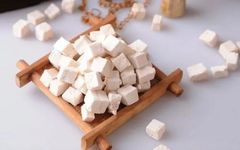
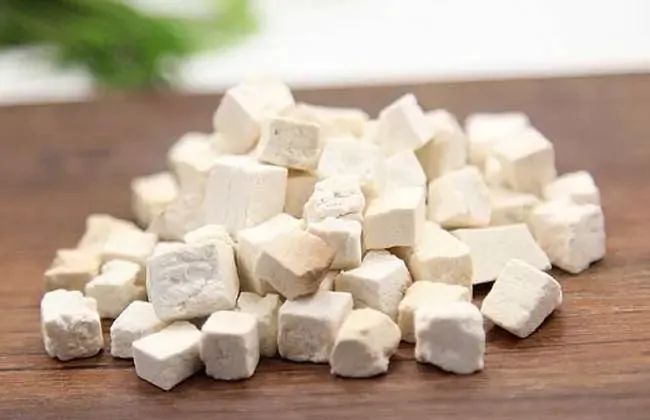
Poria (Fu Ling) is sweet and bland in flavor, neutral in nature, and enters the Heart (Xin), Spleen (Pi), and Kidney (Shen) meridians. It has the effects of promoting urination, leaching out dampness, strengthening the Spleen, and calming the mind. It is primarily decocted in water and is mainly produced in Yunnan, Anhui, Hubei, Sichuan, and Henan provinces of China, with “Yun Poria” being the authentic medicinal material. Clinically, it is commonly used to treat edema, phlegm retention, Spleen deficiency diarrhea, palpitations, and insomnia.
Poria mainly contains two types of compounds: polysaccharides and triterpenes, with polysaccharides accounting for approximately 70% to 90% of its dry weight. It exhibits significant anti-tumor, anti-inflammatory, and immune-regulating effects, primarily composed of β-(1 → 3) glucan branched chains, along with small amounts of β-(1 → 6) glucan branches, rhamnose, xylose, mannose, and galactose. The triterpenes in Poria have various effects, including diuretic, sedative, anti-tumor, blood sugar-lowering, and increasing myocardial contractility.
Mechanisms and Applications of Poria in Tumor Treatment

Porico acid is one of the important components of Poria triterpenes and is considered the main component responsible for its anti-tumor effects. Porico acid can activate poly(ADP-ribose) polymerase, inhibit the proliferation of human breast cancer MDA-MB-231 cells, and induce apoptosis. It downregulates the expression of matrix metalloproteinase-9 (MMP-9), inhibits the migration of breast cancer cells, suppresses interleukin-induced MAPK activation, reduces prostaglandin and protein kinase AKT synthesis, and activates anti-BCL2 to induce mitochondrial apoptosis, thereby exerting anti-cancer effects.
The anti-tumor effects of Poria polysaccharides may be related to their molecular weight and chain structure. The triple helix conformation of β-(1 → 3)D-glucan and the hydrophilic groups located on the outer surface of the helix are the material basis for its action.
Modern clinical applications of Poria mainly involve its use in compound formulas. Gui Zhi Fu Ling Wan (Cinnamon Twig and Poria Pill) can inhibit ovarian cancer microenvironment and tumor angiogenesis by regulating the VEGFR signaling pathway, HIF-1 signaling pathway, and mTOR signaling pathway. It can also reduce the expression levels of estrogen and progesterone in patients with uterine fibroids, thus exerting therapeutic effects on ovarian cancer. In patients with advanced non-small cell lung cancer (NSCLC) receiving chemotherapy, the addition of Bu Yuan Decoction combined with Gui Zhi Fu Ling Wan significantly improved immune function and alleviated adverse reactions. In patients with primary brain tumors undergoing chemotherapy, the addition of Gui Zhi Fu Ling Wan resulted in more significant tumor volume reduction, better recent efficacy, and longer average survival time. In patients with primary liver cancer undergoing interventional therapy, the addition of Si Ni Decoction with Poria showed more significant improvements in liver function, prothrombin time, and T cell subgroups.
Mechanisms and Applications of Poria in Gynecological Diseases
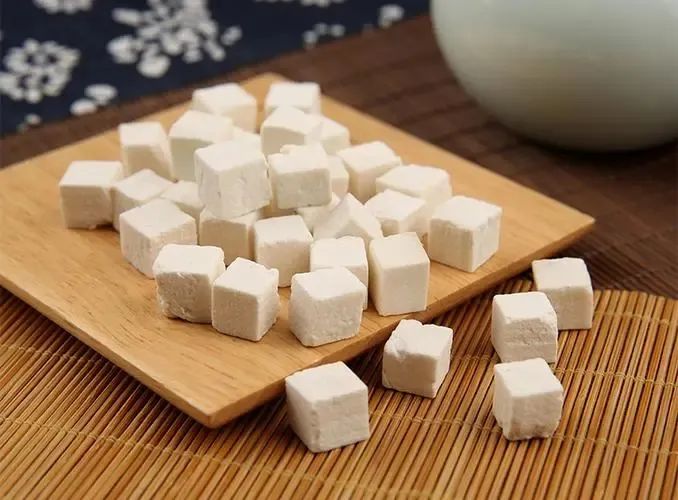
Poria is mainly applied in gynecological diseases in the form of the Chinese patent medicine Gui Zhi Fu Ling Wan (capsules), which originates from Zhang Zhongjing’s “Jin Kui Yao Lue”. The original formula consists of multiple medicinal materials including cinnamon twig, Poria, and peach kernel. Its active components can inhibit the release of inflammatory factors such as TNF-α and interleukin-1β (IL-1β), coordinate complex inflammation-related networks, initiate immune responses, reduce blood viscosity, and improve pregnancy rates, making it widely used in the treatment of gynecological diseases.
Animal experiments have shown that Gui Zhi Fu Ling capsules can improve the levels of prostaglandins, superoxide dismutase, and nitric oxide in the uterine tissues of rats with primary dysmenorrhea, inhibiting endometrial hyperplasia. It can accelerate the clearance of circulating immune complexes (CIC) in rats with chronic pelvic inflammatory disease, enhancing the expression of RBC-C3bR receptors on red blood cell membranes and improving red blood cell immune function. Its mechanism of action is related to the regulation of lipid metabolism and amino acid metabolism.
In clinical applications, Gui Zhi Fu Ling Wan assists in the treatment of patients with endometriosis (EMs), effectively alleviating pain and improving hormone levels. When combined with uterine fibroid treatment, significant improvements in fibroid volume, immune indicators, and sex hormone levels are observed. When combined with moxifloxacin for chronic pelvic inflammatory disease, it improves overall efficacy and reduces inflammatory responses. In elderly patients with ovarian cysts treated with gynecological Qian Jin capsules, levels of NO, TNF-α, and E2 significantly decreased, while LH and FSH levels significantly increased. The pregnancy rate in patients with tubal obstructive infertility significantly improved after taking Gui Zhu Fu Ling capsules, with a decrease in serum TNF-α.
Mechanisms and Applications of Poria in Edema Treatment
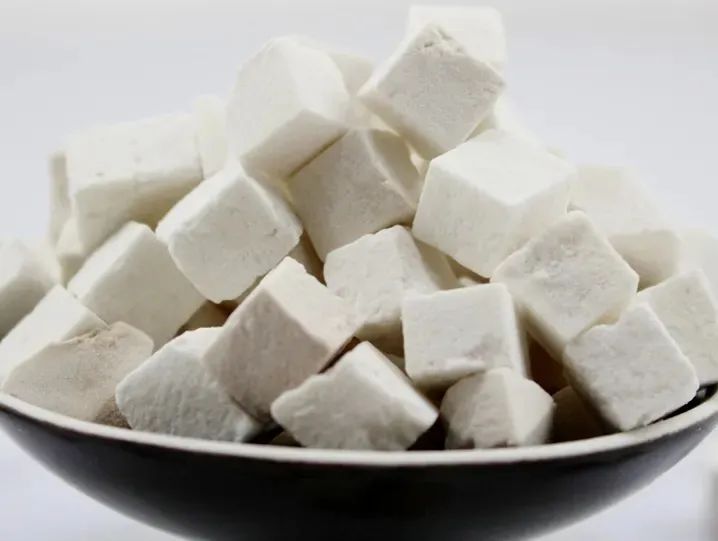
Edema is a term in Traditional Chinese Medicine (TCM) that refers to the retention of body fluids, leading to swelling of the skin. Clinically, patients mainly present with swelling of the head, face, eyelids, limbs, and abdomen, including renal edema, cardiac edema, functional edema, endocrine edema, and hepatic edema.
Poria plays an important role in the treatment of edema due to its ability to promote urination and leach out dampness. Clinically, it is widely used in classic formulas with modifications based on syndrome differentiation.
Animal experiments have confirmed that Poria can protect the gastrointestinal mucosa by regulating serum EGF and MUC2 levels in the small intestine, improving water metabolism disorders by lowering renal AQP1 or AQP2 levels, showing good effects on Spleen deficiency model rats. It also regulates AQP1 and ADHAQP2-related pathways, upregulating body weight, 24-hour urine volume, and serum albumin while lowering total protein, demonstrating significant diuretic and damp-leaching effects. Poria water extract can increase the glomerular filtration rate in model rats with kidney Yang deficiency and edema, accelerating the excretion of metabolites such as serum creatinine (SCr) and blood urea nitrogen (BUN). Additionally, Poria water-soluble polysaccharide solution can effectively prevent the formation of urinary system stones in experimental rats, with its mechanism related to the diuretic effects of Poria polysaccharides, increasing urinary magnesium content, and mitigating oxidative stress.
Clinical studies have shown that Poria mycelium water extract can inhibit the cAMP/PKA pathway and the TonEBP/Sgk1 signaling pathway, regulating renal water balance and exhibiting anti-apoptotic activity on the kidneys. In patients with chronic cor pulmonale heart failure and edema treated with TCM, a dosage of 100g of Poria showed the best diuretic effect without any toxic reactions. In patients with diabetic nephropathy edema receiving conventional Western medicine treatment, the addition of Gui Zhi Fu Ling Wan combined with Zhen Wu Decoction resulted in lower TCM syndrome scores. In patients with hepatitis B virus-related cirrhosis receiving conventional Western medicine treatment, the addition of Jian Pi Li Shui Decoction showed more significant benefits in 24-hour urine volume, waist circumference, liver function, and TCM syndrome scores, along with stronger antiviral capabilities. In patients with cirrhotic ascites receiving conventional Western medicine treatment, the addition of modified Fu Ling Gui Zhi Bai Zhu Gan Cao Decoction showed advantages in improving clinical symptoms and liver function.
Mechanisms and Applications of Poria in Other Disease Treatments
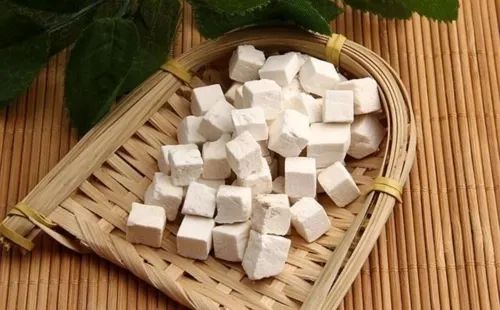
With the continuous development of Traditional Chinese Medicine, the clinical applications of Poria are expanding.
Animal experiments have confirmed that Poria triterpenes can significantly reduce liver injury in mice, exhibiting hepatoprotective effects. After sleep deprivation in rats, inflammatory indicators such as red blood cells, hemoglobin, white blood cells, and neutrophils increased, but these indicators decreased after Poria treatment. Learning, memory, and insomnia conditions in rats significantly improved after Poria intervention.
Clinical studies have shown that Poria polysaccharides possess good antioxidant activity; the combination of Bai Jiang and Poria with Gardenia and Fermented Soybean Decoction can significantly improve insomnia symptoms in patients. When combined with conventional Western medicine treatment for coronary heart disease, the addition of Poria Gui Zhi Bai Zhu Decoction resulted in higher overall efficacy and significant improvements in blood lipid and cardiac function indicators. In patients with alcoholic liver cirrhosis during the compensated phase, the addition of Gui Zhi Fu Ling capsules showed better results.
References: 【1】Wang Zhen, Huang Ke. Research Progress on the Clinical Applications and Mechanisms of Poria (Fu Ling) [J]. Chinese Journal of Drug Abuse Prevention and Treatment, 2022, 9(28): 1175-1178.


